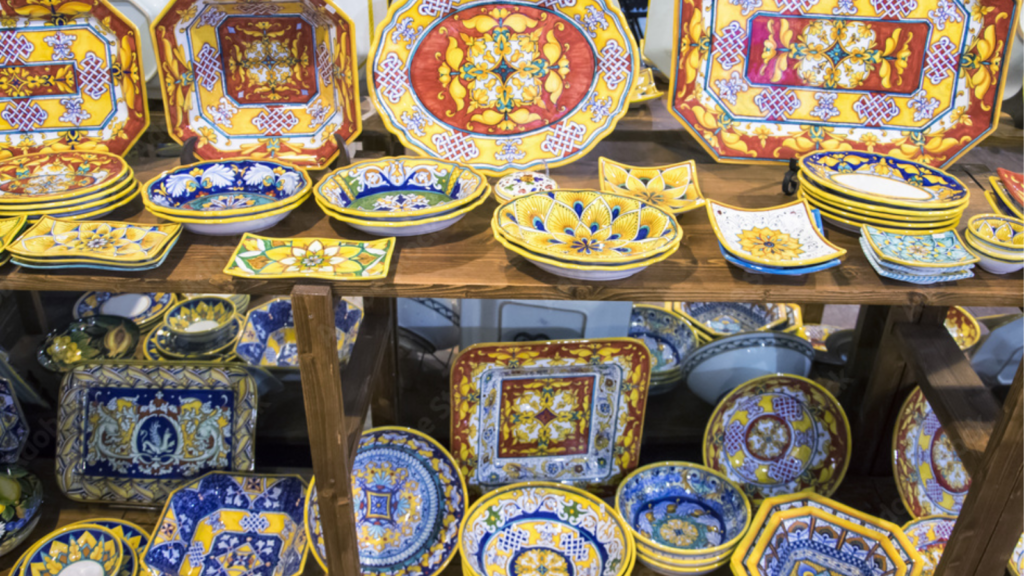Immerse yourself in the rich tapestry of Italian crafts. A realm where tradition meets creativity, these artisanal wonders are a testament to Italy’s cultural heritage. From the intricate glassworks of Murano to the exquisite ceramics of Deruta, Italian crafts are a delightful blend of skill, passion, and history.
Whether you’re a craft enthusiast or a curious traveler, you’ll find Italian crafts offer a fascinating insight into the country’s traditions. Each piece tells a story, a tale of craftsmanship that’s been honed over centuries and passed down through generations. So, let’s embark on this captivating journey, exploring the timeless allure of Italian crafts.
Italian Crafts
 The tapestry, which forms the heritage of Italian crafts, is rich and diverse, held together by a common thread of passion, tradition, and excellence. Centuries-old techniques not only hold storied pasts but breathe life into spectacular artisanal creations, underscoring the country’s creative prowess.
The tapestry, which forms the heritage of Italian crafts, is rich and diverse, held together by a common thread of passion, tradition, and excellence. Centuries-old techniques not only hold storied pasts but breathe life into spectacular artisanal creations, underscoring the country’s creative prowess.
Regional Variations and Traditions
Italy comes alive with regional craft variations, each carrying distinctive traditions that echo the shared artistic heritage. Northern regions, like Lombardy and Veneto, are famous for glassmaking and leatherwork respectively, bearing testament to local resources (Sucher, 2017). Central regions like Tuscany and Le Marche boast fine textile production and remarkable pottery pieces. On the contrary, Southern regions, like Campania and Sicily, showcase vibrant ceramics and detailed woodwork, exuding centuries-old traditions (The Local, 2019). Thus, a canvas of distinct regional variations further strengthens Italy’s diverse craft heritage.
Iconic Italian Craftsmanship
Italy’s repertoire of artisanal wonders stems from a rich history of mastering techniques in various forms of craftsmanship. The country’s regions hold diverse yet equally iconic skills that have molded Italian crafts into masterpieces of excellence.
Venetian Glassblowing
Venetian glassblowing, originating from the island of Murano in Venice, exhibits Italy’s centuries-old tradition of immaculate craftsmanship. Artisans, known for their precision and delicate handling, forge exquisite pieces ranging from intricate jewelry to ornate chandeliers. Each creation dazzles with a blend of vibrant colors, complex patterns, and hallmark Venetian elegance. This mastery over glassblowing, passed down through generations, offers a true testament to the enduring legacy of Italian craftsmanship.
Florentine Leatherworking
In Florence, another form of iconic Italian craftsmanship unfolds. Florentine leatherworking, a craft steeped in the city’s history, is renowned for its superior quality and skillful design. Artisans utilize traditional techniques to work the leather, producing items such as luxurious handbags, robust belts, and sophisticated footwear. Each product, a hallmark of Italian excellence, exudes an aura of refined elegance and robust resilience inherent in Florentine leatherwork.
Techniques and Materials
The Role of Artisan Workshops
Artisan workshops, brimming with skilled craftsmen, yield Italy’s rich array of handcrafted goods. In these spaces, artisans pass on century-old techniques, embodying the heart of Italian craftsmanship in their creations. Notably, Murano glassblowing uses an age-old technique involving molten glass and the craftsman’s breath to create intricate shapes. Likewise, Florentine leatherworking requires an array of tools, from knives to moulding irons, which craftsmen use to convert raw hides into elegant leather goods. Deruta ceramics, on the other hand, demand a steady hand to paint intricate Renaissance patterns unfalteringly.
Sustainable Practices in Italian Crafting
Sustainability is more than a buzzword in Italian crafts; it’s an inherent part of the tradition. These crafts lean into older techniques that value the environment and promote sustainable materials. Handblown glassware from Murano, for instance, derives from glass mixture that requires lesser resources to produce. Florentine leatherworkers often source their hides from the food or agriculture industry, preventing waste. Deruta ceramists, in addition, utilize natural earthenware and pigments, all locally sourced, ensuring a lower environmental impact. Together, these practices champion a vision of sustainable craftwork that is sensitive to the health of the planet, aligning with the ethos of Italian craftsmanship.
Need to Know
Italian crafts tell a story of tradition, skill, and artistry. Whether it’s Murano glassblowing or Florentine leatherworking, each piece embodies the rich tapestry of Italian culture. Recognizing artisan marks and understanding the unique characteristics of these crafts are crucial steps in appreciating their authenticity. With e-commerce platforms and craft fairs, it’s never been easier to support the legacy of Italian craftsmanship from anywhere in the world.
